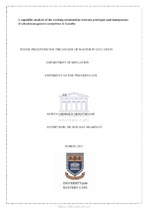| dc.description.abstract | A larger number of schools in Lesotho are owned and controlled by churches whereas the government pays teachers’ salaries and provides school facilities through the national budget. It is through this partnership that the Lesotho government and the churches have a strong link that characterises the Lesotho school management system. However, there have been some major shifts taking place in the education sector of Lesotho that are affecting the way schools are organised, managed and governed. The BCP government considered to revise all the education bills which resulted in the enactment of the LEA of 1995. The LEA of 1995 vested the responsibility of the management of primary schools on democratically elected committees.
The study investigated the working relationships between principals and chairpersons of school management committees (SMCs) of selected church primary schools in Lesotho. The focus of the study was to analyse the working relationships between principals and chairpersons of the SMCs towards their roles and responsibilities as set out in the LEA of 1995. The study was approached from the capability approach. The core of the capability approach is to evaluate the achievement of a society by paying attention to what its members are able to be and to do. One of the roles of the SMCs is to allocate resources in schools by recommending for the appointment of teachers. Therefore, the study utilised the capability approach in order to explore the freedoms that principals have towards choosing resources that they want for schools.
The study adopted the qualitative research approach. Data was collected through three qualitative research instruments namely, semi-structured interviews, observations and document analysis. The interviews were conducted for 16 participants who comprised the chairpersons of the two SMCs (RCC and LEC), principals’ representatives, teachers’ representatives and principals who were non-members of the SMCs. The purpose of the observations was to observe the physical environments, the behaviours of schools as well as the general availability of resources. Document analysis was done in order to draw on the conclusions of the contents of the SMCs’ records of minutes, schools’ financial reports and progress reports. The researcher used different methods of data collection in order to find answers to the research questions and also to achieve the aims of the study. The researcher used both constant comparative method and content analysis to analyse data. The data was analysed and interpreted against the views of the participants and literature review.
The study confirmed that in both of the SMCs, most of the principals generally had satisfactory working relationships with the chairpersons. The findings of this study revealed that even though the SMCs perform their roles and responsibilities as set out in the LEA of 1995, there are some broad challenges that church schools face that emanate from the social conversion factors such as social norms, culture and practices within church schools, and environmental conversion factors like geographical locations. The findings further revealed that lack of adequate resources such as classrooms and teachers hampered the teachers’ capability to deliver instruction in a normal way because they had to teach multi-grades. These were found to be the challenges that affected the principals’ freedoms and capabilities to use and convert resources into achievement. Furthermore, the study exposed fair decision-making regarding resource allocation by the SMCs. Principal were free to use school funds as long as they submit the financial reports to the SMCs at the end of the year. However, the conclusion drawn from document analysis showed that not all the schools under study submitted financial reports. The findings reflect that there are no transparent guarantees in some of the school regarding the control and use of school funds. The findings of this study have some implications and recommendations to the Ministry of Education and training, church schools, teachers and principals who wish to work in church schools. The study recommends that the Ministry of Education and Training should reconsider the representation of one principal for six schools in the SMCs by establishing the school management system that calls for one school management committee per school. The Ministry of Education and Training in partnership with churches should make efforts to delineate the appropriate roles of churches in the provision of education with regard to the local hiring system whereby the SMCs select teachers to be appointed in their schools. Teachers should be transferred to the schools where multi-grade teaching is still practised in order to rationalise distribution of teachers in church schools. Principals and teachers should make informed decisions when choosing the schools that they want to work at, especially if it is a church school. They should make sure that the church schools they choose to be appointed to shall serve their beliefs, not only to focus on salaries. | en_US |

